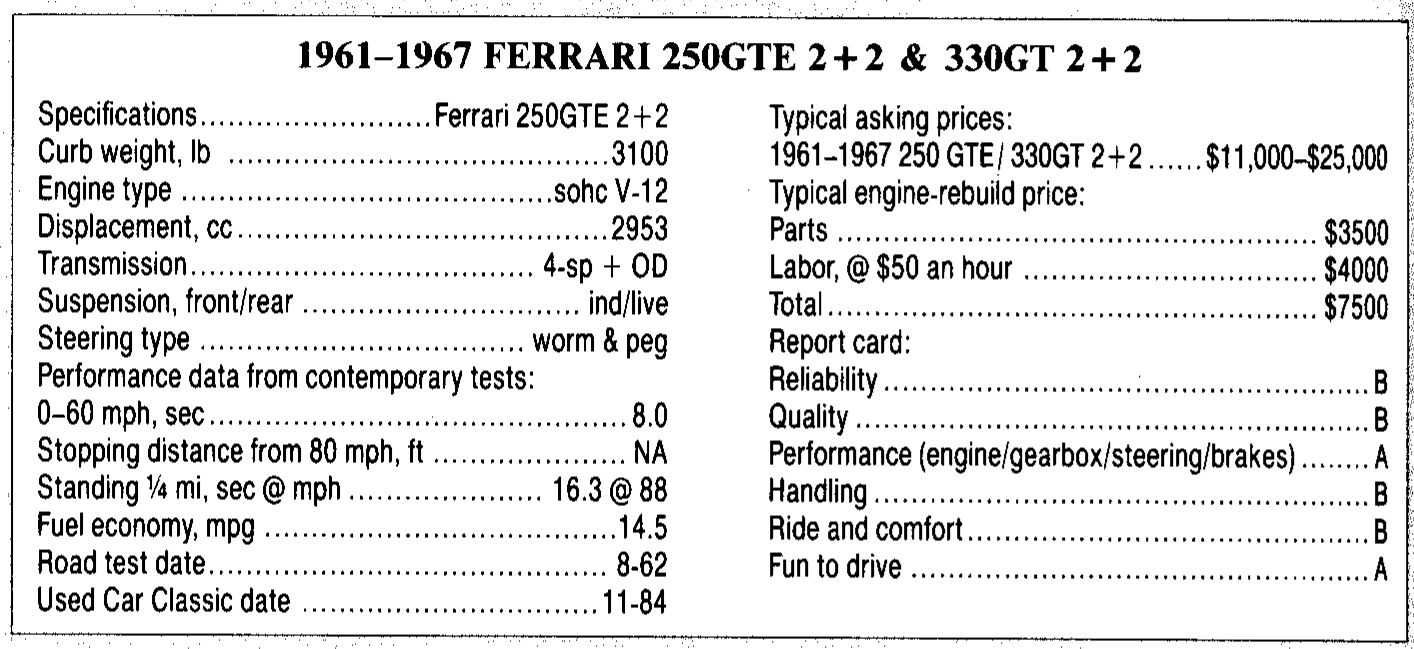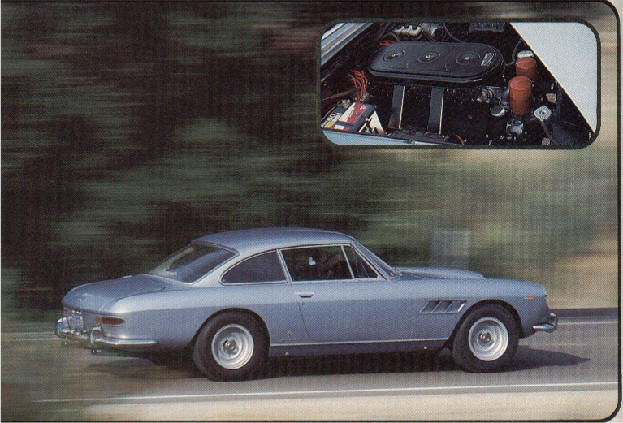 | 330 GT Registry |  |
1961-1967
Ferrari 250GTE
2+2 & 330GT 2+2
Of some 30 cars on our initial list of choices, only the Ferrari 250GTE 2+2 and 330GT 2+2 came close to receiving a unanimous vote from the staff. Ferrari’s magic has certainly infected R&T’s staff over the years like that of no other car. We even have a great respect for the contemporary 8-cylinder 308s.
But our true affections lie with 12-cylinder Ferraris. The heart and soul of any Ferrari is its engine, and the classic Ferrari engine is the Colombo-designed V-12. You can’t get it in the $54,000 308, the $65,000 Mondial or any other Ferrari officially imported into the U.S. today.
However, for around $20,000, and of ten less, you can get it in a 250GTE 2+2 or a 330GT 2+2. And because Enzo Ferrari is Italian and has never forgotten the importance of style, you’ll also get an attractive Pininfarina-styled body.
Fifteen or 20 thousand dollars is not an inconsiderable sum for most of us, but if you know the background of these 2+2s, you’ll understand why they’re genuine bargains. Enzo Ferrari’s passion has al ways been racing. Following World War II, his company built race cars, which, with as few modifications as necessary, made them civilized enough to appeal to hairy-chested wealthy folk who could use them either on the road or on the track. Overtime, Ferrari’s race cars and road cars have come to bear less resemblance to one another, thanks to changes in the rules of international auto racing and to government-imposed automobile safety and emissions regulations.
But between the innocent Fifties and burdensome Seventies, the dual-purpose Ferrari reached its peak with variations of a model called the 250GT. The 250GT berlinetta Tour de France, the 250GT short-wheelbase berlinetta, the 250GT Spyder California and the legendary 250GT0 were cars that could be used on the street. But they were also cars that dominated rallies, hillclimbs and endurance racing of the time as well.
All the 250GTs have much in common. They all use strong ladder-type frames. They all have similar live rear axles. They all came with gorgeous Borrani wire wheels. Most important, they all have the Colombo V-12 engine. As for their driving characteristics, they all seem rather ponderous and tiresome at low speeds. But once up to 60 mph or so, their well bred manners become apparent. The ride smooths, the steering lightens and the car seems to come alive. In all these respects, our subject here, the 250GTE 2+2, is no different from the other famed members of the 250GT family.
However, the car is different in that it can carry four people in reasonable com fort while the other models are strictly 2-seaters. Today the price variations between the models are astronomical. But when the cars were new there was only about $1000 difference between a racier 250 short-wheelbase Berlinetta, for in stance, and the 250GTE 2+2, the latter car originally selling for just over $12,000.
The 2500TE made its debut in 1960 and went into production the following year. By the end of 1963, the GTE’s 2953-cc, 240-bhp engine was beginning to seem tame. So Ferrari installed a 3967-cc, 300-bhp version of the same Colombo-de signed V-12 in the 250GTE. This car was christened the 330 America. A revised body came along a few months later, and the car changed monikers again, to the 330GT 2+2 (not to be confused with the 330GTC, a later 2-passenger car). The body didn’t have the 250GTE’s tail fins, which was an improvement, but it did have a baroque cluster of twin headlamps on each side in place of the earlier cars’ single lamps. In the middle of 1965, the 330GT returned to single headlamps, thank goodness. and at the same time alloy wheels replaced the Borrani wires.
These so-called Series II cars were also the first of the 2 + 2s with the options of power assisted steering and air conditioning. Al together. 950 250GTEs, 50 Americas and 1080 330GTs left the factory before production of the models ended in 1967.
There’s a theory about the 2 + 2 Ferraris that says when Enzo dies everybody will want one of these wonderful cars and that prices will suddenly rise. I don’t know about that. All I know is that there are better reasons than investment potential to buy any Ferrari.


ROAD & TRACK October 1985
Copyright 1985, CBS, Inc.
